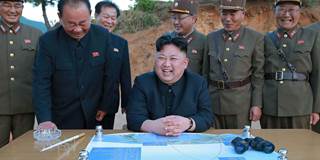US President Donald Trump surely has plenty to worry about at home nowadays. But his administration’s focus on its domestic political problems, together with its lack of a coherent Asia policy, threatens to empower one of the world’s most dangerous regimes and imperil an economically vital – and strategically unstable – region.
CAMBRIDGE – Shortly before he departed the White House, President Barack Obama warned his successor that North Korea would soon be the United States’ most dangerous strategic problem. Donald Trump responded in his usual cavalier way: he blustered, and then, after wining and dining with Chinese President Xi Jinping in early April, he softened his hardline stance toward the country, in order to encourage the Chinese to rein in their wayward ally. But the Democratic People’s Republic of Korea (DPRK) seems to be one step ahead of Trump. Even with a heavy concentration of US military power at its doorstep, it continues to launch missiles.
Across Northeast Asia, almost all of North Korea’s neighbors view the country as a persistent provocation and lament their lack of tools for dealing with such a bizarre regime. With a dearth of feasible options, East Asia’s regional powers have for decades lacked any truly viable strategy to address the multiple challenges –nuclear threat, economic underdevelopment, and human rights violations – posed by the DPRK.
China and Russia, the two powers that have long backed the DPRK, call for diplomacy, while the US has almost always proclaimed the need for toughness: tighter sanctions and a stricter military posture. South Korea (also known as the Republic of Korea, or ROK) and Japan agree that sanctions and greater military readiness are fundamental to addressing the challenges posed by the DPRK, but then generally recoil at the thought of leaving Seoul or Tokyo so vulnerable to the North Koreans.

CAMBRIDGE – Shortly before he departed the White House, President Barack Obama warned his successor that North Korea would soon be the United States’ most dangerous strategic problem. Donald Trump responded in his usual cavalier way: he blustered, and then, after wining and dining with Chinese President Xi Jinping in early April, he softened his hardline stance toward the country, in order to encourage the Chinese to rein in their wayward ally. But the Democratic People’s Republic of Korea (DPRK) seems to be one step ahead of Trump. Even with a heavy concentration of US military power at its doorstep, it continues to launch missiles.
Across Northeast Asia, almost all of North Korea’s neighbors view the country as a persistent provocation and lament their lack of tools for dealing with such a bizarre regime. With a dearth of feasible options, East Asia’s regional powers have for decades lacked any truly viable strategy to address the multiple challenges –nuclear threat, economic underdevelopment, and human rights violations – posed by the DPRK.
China and Russia, the two powers that have long backed the DPRK, call for diplomacy, while the US has almost always proclaimed the need for toughness: tighter sanctions and a stricter military posture. South Korea (also known as the Republic of Korea, or ROK) and Japan agree that sanctions and greater military readiness are fundamental to addressing the challenges posed by the DPRK, but then generally recoil at the thought of leaving Seoul or Tokyo so vulnerable to the North Koreans.